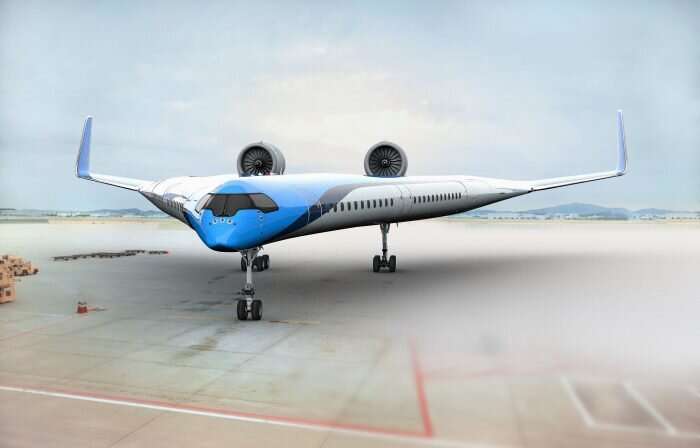June 6, 2019 weblog
Flying-V plane concept marks spectacular new look in air travel

Seating airline passengers in the wings? Think about it. A V-shaped plane designed to carry passengers, cargo, and fuel tanks in its wings is being seeded as a good idea for the future.
Bloomberg said it plain and simple: Planes may receive a drastic facelift.
What drives the appetite to play with new designs: a practical interest in reducing carbon emissions and improving efficiencies.
It is no secret that climate change researchers recognize the role that airplanes play in emissions. Architectural Digest reported that the Rhodium Group released a study showing U.S. carbon dioxide emissions surged in 2018 by 3.4 percent. The leading cause, the study found, was not emissions from cars but from trucks—and airplanes.
"Globally," said the AD article, "airlines carried 4.3 billion passengers in 2018, an increase of 38 million compared to 2017. With these types of statistics and global trends, both in air travel and climate change, we will need much fuel-efficient airplanes."
The Dutch aviation sector has an action plan. Last year, a plan to Minister Cora van Nieuwenhuizen of Infrastructure and Water Management on making air travel more sustainable was submitted. Twenty transport organisations and knowledge institutions joined forces. Reason: to speed up developments for making aviation more sustainable. The aim was to decrease Dutch aviation's CO2 emissions by 35 percent by the end of 2030.
Moreover, Dutch airline KLM will help fund the V-shaped plane concept, which is being developed by Delft University of Technology.
Back story: The Flying-V initially was designed by a student at the Technical University of Berlin. Specifically, it was an idea of TU Berlin student Justus Benad during his thesis project at Airbus Hamburg.
Roelof Vos, an assistant professor at the aerospace engineering faculty of Delft University of Technology, now heads the team in charge of the Flying-V project. "I was intrigued and thought it deserved a closer inspection. So I started an independent study with some students and found an even greater amount of fuel efficiency than suggested in the initial study."
How many passengers? The airplane could carry 314 passengers and cargo. The layout would look like this: the aircraft split into two sections toward the rear, said Bloomberg, for body and wings combined. In Architectural Digest, the head of the Flying-V team said that "In a traditional design, the fuselage produces a significant amount of drag, yet in the Flying-V the body and wings are merged into a single component, creating much more lift and much less drag."
The design mimics the Airbus A350's 213-foot wingspan. The similarity would enable Flying V to use existing airport infrastructure. TUDelft provided a comparison and contrast. With the same wing span, the Flying-V can use the present infrastructure such as gates and runways. It fits in the same hangar as an A350. The Flying-V carries about the same number of passengers - 314 in the standard configuration – and the same amount of cargo, 160 m3.
The Flying-V, though, is smaller than the A350. It has "less inflow surface area compared to the available amount of volume. The result is less resistance. That means the Flying-V needs less fuel for the same distance."
Moving forward, you will not see such planes soon. The planes are years away from reality and awaiting numerous tests.
Later this year, though, plans involve a smaller-scale model.
"In October 2019," said TUDelft, "researchers will present a flying prototype that will be used to test whether the Flying-V can remain stable and reliable while being flown at low speeds – during take-off and landing."
More information: www.tudelft.nl/en/ae/flying-v/
© 2019 Science X Network



















